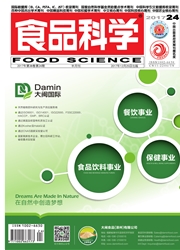

 中文摘要:
中文摘要:
用Plackett-Burman试验设计和响应面法(response surface methodology,RSM)对镰刀霉菌JN158产色素的发酵培养基7种营养物质配比进行优化。结果表明:蔗糖、花生饼粉和FeSO4·7H2O的添加量显著影响色素产量;用最陡爬坡试验使这3个显著因素的添加量接近最大响应区域,优化后,镰刀霉菌产色素的培养基添加量分别为:蔗糖30.18 g/L、花生饼粉4.86 g/L、K2HPO4·3H2O 1 g/L、NaCl 0.5 g/L、MgSO4·7H2O 0.5 g/L、CaCl20.5 g/L、FeSO4·7H2O 0.0122 g/L,预测的最大色素产量是1.268 g/L,验证实验得到的色素产量为(1.252±0.011)g/L,与预测值相近,优化后色素的产量是以前的2.9倍。
 英文摘要:
英文摘要:
Plackett-Burman design and response surface methodology (RSM) were applied to optimize 7 components in the medium for pigment production by Fusarium sp.JN158. The results showed that the yield of pigment was mainly influenced by the concentrations of glucose, peanut meal and FeSO4·7H2O. With central composite design and RSM, the optimal medium composition and concentrations was determined to be sucrose (30.18 g/L), peanut meal (4.86 g/L), K2HPO4·3H2O(1 g/L),NaCl (0.5 g/L), MgSO4·7H2O (0.5 g/L), CaCl2 (0.5 g/L), and FeSO4·7H2O (0.0122 g/L). The experimental yield of pigment produced by Fusarium sp. JN158 in the optimized medium was (1.252±0.011) g/L, which was close to the predicted value of 1.268 g/L.
 同期刊论文项目
同期刊论文项目
 同项目期刊论文
同项目期刊论文
 期刊信息
期刊信息
